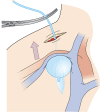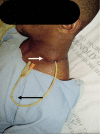Penetrating neck injuries: a guide to evaluation and management
- PMID: 29046084
- PMCID: PMC5849205
- DOI: 10.1308/rcsbull.2018.6
Penetrating neck injuries: a guide to evaluation and management
Abstract
Introduction Penetrating neck injury is a relatively uncommon trauma presentation with the potential for significant morbidity and possible mortality. There are no international consensus guidelines on penetrating neck injury management and published reviews tend to focus on traditional zonal approaches. Recent improvements in imaging modalities have altered the way in which penetrating neck injuries are now best approached with a more conservative stance. A literature review was completed to provide clinicians with a current practice guideline for evaluation and management of penetrating neck injuries. Methods A comprehensive MEDLINE (PubMed) literature search was conducted using the search terms 'penetrating neck injury', 'penetrating neck trauma', 'management', 'guidelines' and approach. All articles in English were considered. Articles with only limited relevance to the review were subsequently discarded. All other articles which had clear relevance concerning the epidemiology, clinical features and surgical management of penetrating neck injuries were included. Results After initial resuscitation with Advanced Trauma Life Support principles, penetrating neck injury management depends on whether the patient is stable or unstable on clinical evaluation. Patients whose condition is unstable should undergo immediate operative exploration. Patients whose condition is stable who lack hard signs should undergo multidetector helical computed tomography with angiography for evaluation of the injury, regardless of the zone of injury. Conclusions The 'no zonal approach' to penetrating neck trauma is a selective approach with superior patient outcomes in comparison with traditional management principles. We present an evidence-based, algorithmic and practical guide for clinicians to use when assessing and managing penetrating neck injury.
Keywords: Management; Penetrating neck injury; Review; Trauma.
Figures




References
-
- Saito N, Hito R, Burke PA, Sakai O. Imaging of penetrating injuries of the head and neck: current practice at a level I trauma center in the United States. Keio J Med 2014; : 23–33. - PubMed
-
- Hussain Zaidi SM, Ahmad R. Penetrating neck trauma: a case for conservative approach. Am J Otolaryngol 2011; : 591–596. - PubMed
-
- Siau RT, Moore A, Ahmed T et al. . Management of penetrating neck injuries at a London trauma centre. Eur Arch Otorhinolaryngol 2013; : 2,123–8. - PubMed
-
- Burgess CA, Dale OT, Almeyda R, Corbridge RJ. An evidence based review of the assessment and management of penetrating neck trauma. Clin Otolaryngol 2012; : 44–52. - PubMed
Publication types
MeSH terms
LinkOut - more resources
Full Text Sources
Other Literature Sources
Medical

